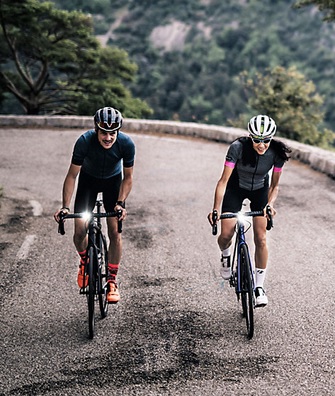Gears & Gadgets: Daytime Running Lights
by David Cohen, Maryland National Capital Park Police Reserve Unit
The concept of Daytime Running Lights (DRLs) is certainly not new. They were developed for cars, mostly in Northern Europe and Scandinavian countries where the winter days are short and light is low, and in countries like Great Britain, which have more than their share of murky weather. The idea was that the lights would run at X percent of the full headlight power so that cars could be seen under less than optimal lighting conditions. DRLs eventually made their way to the United States and are now standard equipment on most new cars.
Recently, DRLs have made inroads within the cycling community. While night lighting has been around in some form almost as long as bicycles, lighting technology over the past 15 years has dramatically improved with the introduction of HID and LED lighting. Once promoted only for lighting up the night, this technology has been brought to daytime riding.
There is a dizzying array of DRL-type lighting available. Many are very cheap, have cutesy names like “SuperBright”, and can be ordered from Amazon. I have learned that the cheap lighting is inexpensive for a reason. Features like battery life and ruggedness are severely lacking. Still, even cheap lighting is better than no lighting.
I’d recommend purchasing a light from a reputable bike brand. I picked up a set of Bontrager Ion 200 RTs. They were not cheap, retailing at $114.99 at my local bike shop. However, the quality of the product is head-and-shoulders above the flimsy “dime a dozen” LED lights. And, frankly, do you really want to skimp when it comes to safety?
As with lights for night riding, lumens are the lighting measurements for DRLs. Unlike night-time illumination, however, DRLs do not need put out 900 lumens. I’d recommend a DRL with no less than 100 lumens, but for daytime lighting purposes, anything over 300 is probably overkill as well. According to Bontrager, their 200 lumen unit can be seen at a distance of about 1.25 miles (2 km) on its “Day Flash” setting.
While many riders only opt for the rear-facing red light, statistics have borne out that only a small percentage of bicycle crashes occur from a driver overtaking from the rear. Most occur from the front, with a driver making a turn in front of the cyclist being the most common cause. That does more than suggest that a forward-flashing DRL is every bit as important as a rear-facing one.
So, do they work? Studies from the automotive world point to DRLs role in reducing motorcyclists’ crash risk by 4-20% (varies by country) and crashes involving passenger vehicles by 5-10%, depending on country and vehicle type. While several studies mention the effects of automobile DRLs on cyclists and pedestrians, I was unable to find any studies of the effectiveness of bicycle-mounted DRLs. In my own experience, they definitely appear to make a difference, as the number of instances when a driver decelerates while approaching me has noticeably increased. I also find their use effective on hiker/biker trails as a way of making pedestrians and oncoming riders much more aware of my presence.
While on duty as an auxiliary with the Maryland-National Capital Park Police, I employed DRLs during the July 4th fireworks detail as well as patrolling the Capital Crescent Trail, one of the busiest multi-use trails in the country. Compared to previous patrols without the DRLs, it seemed we were more easily spotted both by vehicular and pedestrian traffic.
As a driver, I’ve noticed that I am able to spot a blinking DRL at ranges beyond which my eyesight is able to perceive the actual bike and rider. The 1.25 mile range claimed by Bontrager appears to be close to reality, based on my experience of driving along a secondary road in Delaware and being able to detect a cyclist using DRLs at one mile distant.
I would surmise that, yes, DRLs for bicycles do work. Certainly, there are times when visibility may not be as important as being stealthy. In those cases, the patroller can simply extinguish the lights.
However, for all other times, including routine patrolling, DRLs should be considered as essential as a helmet or gloves. Other than off-road riding on singletrack trails, DRLs should also be an essential part of your off-duty kit. As I mentioned above – cheap DRLs are still better none, but the extra dollars you spend could very well save your life.
References:
Davoodi, SR & Hossayni, SM. “Role of Motorcycle Running Lights in Reducing Motorcycle Crashes During Daytime: A Review of the Literature”. Bulletin of Emergency and Trauma. 2015; 3(3):73-78. dio 10.7508/beat.2015.03.001. https://www.ncbi.nlm.nih.gov/pmc/articles/PMC4771245/. Accessed December 2019.
Minnesota Department of Transportation. Effects of 24-Hour Headlight Use on Traffic Safety Transportation Research Synthesis Report, November 2010. https://www.dot.state.mn.us/research/TRS/2011/TRS1009.pdf. Accessed December 2019.
Wang, J., National Highway Traffic Safety Administration. Effectiveness of Daytime Running Lights for Passenger Vehicles, DOT HS 811 029, September 2008. https://crashstats.nhtsa.dot.gov/Api/Public/ViewPublication/811029. Accessed December 2019.
Gears & Gadgets is a blog written by David Cohen #1116. It features various repair tips and tricks that David has picked up in nearly 25 years of cycling, including 12 years of public safety cycling. Gears & Gadgets will also periodically review some of the latest “gadget” items of potential interest to public safety cyclists. The advice and opinions in this column are solely the author’s and should not be interpreted as IPMBA mandates or recommendations unless explicitly stated.
About the author: David Cohen is a 12 year volunteer with the Maryland-National Capital Park Police. When he isn’t riding or tinkering with bicycles, David can be found tinkering with vintage cars or World War II airplanes. An avid historian, David enjoys researching and writing as well. He can be reached at onyxsax@aol.com.

